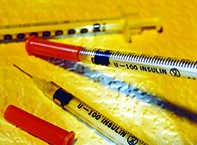Peer Reviewed
Feature Article Endocrinology and metabolism
KISS: ‘keep insulin safe and simple’. Part 2: living with insulin and type 2 diabetes
Abstract
Living with insulin and type 2 diabetes 24 hours a day, seven days a week, can be associated with problems if they are not anticipated and avoided.
Key Points
- Continuing oral hypoglycaemic agents and adding 10 units of basal insulin at bedtime is almost always the best way to start insulin in people with type 2 diabetes. Metformin also helps with weight control.
- Patients should ‘eat less and walk more’ to balance the extra energy available when improved glycaemia reduces glycosuria.
- Insulin should be adjusted to fit lifestyle, not vice versa.
- Improving glycaemic control comes with the price of hypoglycaemia, weight gain and extra effort by patient and doctor.
- Blood glucose measurement results may vary by plus or minus 20%, even after the patient’s technique and the testing equipment have been checked.
- Eating before physical activity reduces the risk of hypoglycaemia and blunts postprandial hyperglycaemia.
- When travelling by air, patients should adjust insulin dosages if the time zone difference between origin and destination is more than four hours. Less insulin is needed for travel eastwards (a shorter day) and more insulin for travel westwards (a longer day).
- Patients should carry a full set of diabetes equipment in their hand luggage when flying. Taking a survival kit in the hand luggage and a second full set of diabetes equipment in the check-in luggage is recommended. Airline regulations on the carriage of diabetes equipment should be checked.
Purchase the PDF version of this article
Already a subscriber? Login here.

